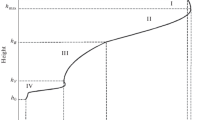Abstract
The effectiveness of performance of the HF radio communication systems depends in many aspects on the accuracy of description of ionospheric conditions. One of possibilities of such a description is to use the IRI model. In the paper it is shown that discrepancies of the model N(h)-profile shape and the real shape can make a contribution to errors of description of ionospheric conditions by means of the IRI model. A residual difference (RD) remains even after adjusting the IRI model to the real-time parameters of foF2 and hmF2. These differences are estimated for the N(h)-profiles calculated from ionograms by the traditional method POLAN and the new method NeXtYZ. Estimates are given for the influence of these differences on the prediction accuracy of such parameters as the maximum usable frequency and the distance D between transmitters and receivers. An attempt was made to decrease the residual difference along the HF path by means of an analytical function approximating RD.
Similar content being viewed by others
References
Anderson, D., 2000, Ionospheric Models, NOAA Space Environment Center, http://lws.gsfc.nasa.gov/documents/mission_requir_ws_2_2000/anderson.pdf.
Bilitza, D., 2001, International Reference Ionosphere, Radio Sci. 36, 261–275.
Bilitza, D., N.M. Shikh and R. Eyfrid, 1979, A global model for the height of the F2-peak using M3000 values from the CCIR numerical map, Telecomm. J. 46, 549–553.
Buresova, D., L.R. Cander, A. Vernon and B. Zolesi, 2006, Effectiveness of the IRI-2001-predicted N(h) profile updating with real-time measurements under intense geomagnetic storm conditions over Europe, Adv. Space Res. 37, 1061–1068.
Fox, M.W., and C. Blundell, 1989, Automatic scaling of digital ionograms, Radio Sci. 24, 747–761.
Gilbert, J.D., and R.W. Smith, 1988, A comparison between the automatic ionogram scaling system ARTIST and the standard manual method, Radio Sci. 23, 968–974.
Grozov, V.P., and G.V. Kotovich, 2003, A comparison of results derived from scaling VS chirp-ionosonde ionograms with the International Reference Ionosphere (IRI), J. Atm. Solar-Terr. Phys. 65, 409–416.
Kiyanovsky, M.P.(ed.), 1971, Ray approximation and problems of radio wave propagation, Nauka, Moscow, 287–298.
McNamara, L.F., 1988, Ionospheric modeling in support of single location of long range transmitters, J. Atm. Terr. Phys. 50, 781–795.
Pezzopane, M., and C. Scotto, 2005, The INGV software for the automatic scaling of foF2 and MUF(3000)F2 from ionograms: A performance comparison with ARTIST 4.01 from Rome data, J. Atm. Solar-Terr. Phys. 67, 1063–1073.
Reinisch, B.W., and X. Huang, 1983, Automatic calculation of electron density profiles from digital ionograms, 3, Processing of bottomside ionograms, Radio Sci. 18, 477–492.
Reinisch, B.W., I.A. Galkin, G. Khmyrov, A. Kozlov and D.F. Kitrosser, 2004, Automated collection and dissemination of ionospheric data from the digisonde network, Adv. Radio Res. 2, 241–247.
Schunk, R.W. (ed.), 1996, STEP: Handbook of Ionospheric Models, Utah State Univ., Logan, Utah.
Titheridge, J.E., 1985, Report UAG-93, World Data Center A, NOAA E/GC2, 325, Broadway, Boulder, Colorado 80303.
Titheridge, J.E., 2000, Modeling the peak of the ionospheric E-layer, J. Atmos. Solar-Terr. Phys. 62, 93–114.
Titheridge, J.E., 2001, Production of the low-latitude night E layer, J. Geophys. Res. 106, 781–786.
Titheridge, J.E., 2003a, Model results for the daytime ionospheric E and valley regions, J. Atmos. Solar-Terr. Phys. 65,129–137.
Titheridge, J.E., 2003b, Ionization below the night F2 layer — a global model, J. Atmos. Solar-Terr. Phys. 65, 1035–1052.
Tsagouri, I., B. Zolezi, A. Belehaki and L.R. Cander, 2005, Evaluation of the performance of the real-time updated simplified ionospheric regional model of the European area, J. Atm. Solar-Terr. Phys. 67, 1137–1147.
Wang, C., G. Hajj, X. Pi, I.G. Rosen and B. Wilson, 2004, Development of the Global Assimilative Ionospheric Model, Radio Sci. 39, RS1S06, doi: 10.1029/2002RS002854.
Zabotin, N.A., J.W. Wright and G.A. Zhbankov, 2005, New approaches in the problem of electron density inversion from dynasonde measurements using three-dimensional echolocation data, IES2005 Symposium, Alexandria, VI, 3-4 May 2005, 7B51-7B58.
Author information
Authors and Affiliations
Rights and permissions
About this article
Cite this article
Maltseva, O.A., Poltavsky, O.S. & Shlyupkin, A.S. The IRI model residual difference and the new method of N(h)-profile determination. Acta Geophys. 55, 441–458 (2007). https://doi.org/10.2478/s11600-007-0014-6
Received:
Accepted:
Published:
Issue Date:
DOI: https://doi.org/10.2478/s11600-007-0014-6




